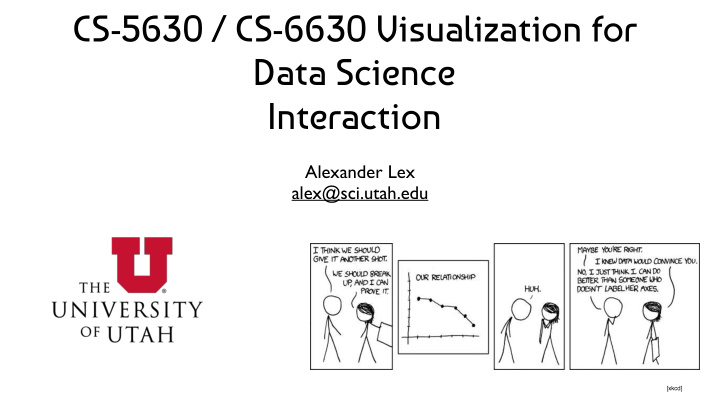



CS-5630 / CS-6630 Visualization for Data Science Interaction Alexander Lex alex@sci.utah.edu [xkcd]
IEEE VIS THE Conference for data visualization Held virtually, hosted by the University of Utah 25-30 October Free registration before October 9 ieeevis.org Attend at least TWO sessions instead of class. Give short summary of session for Activities
Project It’s time to start thinking about your project. Announce your project by Oct 19 Your project proposal, due Oct 26 Come to office hours! What you need: A team – use #looking-f-teammember channel An idea A dataset (that you actually can get!) http://dataviscourse.net/2019/resources/ More Info: http://dataviscourse.net/2020/project/
Stages Announcement (not graded) Proposal (5%) Project Milestone (10%) Final Project (25%) Process Book Narrated Video Vis live on website
Project Requirements Scope as agreed upon with TAs Be ambitious! Define your goals and categorize them: must have, nice to have, etc. check out the hall of fame! Minimum: original idea of dataset/vis combo interactive at least two coordinated views
Dos and Don’ts Do a custom visualization Do a newspaper-style visualization – add narration and storytelling Don’t build a generic exploration tool – focus on one dataset Communicate your project well, on website, on video.
Next Week Tuesday: Advanced JS and D3 (Devin) Thursday: Views; Focus and Contex
Interaction
Spectrum Dynamic Content Static Content 1. Animated Content e.g., infographics, books “Auto-play”, user not in control 2. Interactive Content Changes are a result of user actions
Why Interact with Visualization? Explore data that is big / complex There is too much data There are too many ways to show it http://www.nytimes.com/interactive/2013/05/25/sunday-review/corporate-taxes.html
Why Interact with Visualization? Interaction amplifies cognition We understand things better if we can touch them if we can observe cause and effect
Interaction Methods What do you design for? Mouse, keyboard? Touch interaction / mobile? Gestures? Eye Movement? Speech? https://www.youtube.com/watch?v=QXLfT9sFcbc
Direct Manipulation Interact directly with object Compare to using a query, a slider, etc. Continuous feedback / updates
Types of Interaction Single View Multiple Views Change over time Selection (Details on Demand) Navigation Linking & Brushing Semantic zooming Adapting Representations Filtering and Querying Focus + Context Future Lecture
Purposes of Interaction Data & View Specification, View Manipulation https://taggle-daily.caleydoapp.org / Process and Provenance: https://gapminder.caleydoapp.org/#clue_graph=clue_gapminder0&clue_state=30&clue=P&clue_slide=41
Change over Time / Transitions
Change over Time Use, e.g., slider to see view with data at different times Sometimes better to show difference explicitly [Lauren Wood]
Why Transition? Different representations support different tasks bar chart, vs stacked bar chart Change Ordering Transition make it possible for users to track what is going on
Animated Transitions Smooth interpolation between states or visualization techniques [Sunburst by John Stasko, Implementation in Caleydo by Christian Partl]
Why Animated Transition? https://www.youtube.com/watch?v=vLk7mlAtEXI
Animation Caveats Changes can be hard to track Eyes over memory! Show all states in multiple views
Navigation
Navigation Pan move around Zoom enlarge/ make smaller (move camera) Rotate
Scrollytelling Telling an interactive story Interaction by scrolling Nice but Continuous scrolling vs discrete states Direct access Unexpected behavior https://eagereyes.org/blog/2016/the-scrollytelling-scourge
Example: Oil Prices http://www.nytimes.com/interactive/2015/09/30/business/how-the-us-and-opec-drive-oil-prices.html?_r=0
Example: What’s Warming the World Sent in by Siddartha Ravichandran www.bloomberg.com/graphics/2015-whats-warming-the-world/
Semantic Zooming
Semantic Zoom
Semantic Zooming As you zoom in, content is updated More detail as more space becomes available Ideally readable at multiple resolutions [McLachlan 2008]
Focus + Context
Focus + Context carefully pick what to show hint at what you are not showing
Focus + Context synthesis of visual encoding and interaction user selects region of interest (focus) through navigation or selection provide context through aggregation reduction layering
Elision focus items shown in detail, other items summarized for context
SpaceTree Grosjean 2002
Degree of Interest (DOI) based on observation that humans often represent their own neighborhood in detail, yet only major landmarks far away goal is balance between local detail and global context DOI(x) = API(x) - D(x,y) API – a priori interest D – a distance function to the current focus can have multiple foci Furnas 1986
DOI Tree interactive trees with animated transitions that fit within a bounded region of space layout depends on the user’s estimated DOI use: logical filtering based on DOI geometric distortion of node size based on DOI semantic zooming on content based on node size [Heer 2004] aggregate representations of elided subtrees
DOI without distance function Distance function can lead to big, involuntary changes. Useful also without distance function https://youtu.be/EAjNxFgsJ58?t=244
Superimpose focus layer limited to a local region of view, instead of stretching across the entire view
Toolglass & Magic Lenses Magic Lens: details/different data is shown when moving a lens over a scene [Bier, Siggraph 1993]
Magic Lens with Tangible Interface [Spindler, CHI 2010]
Magic Lense: Labeling [Fekete and Plaisant, 1999]
Distortion use geometric distortion of the contextual regions to make room for the details in the focus region(s)
http://advanse.lirmm.fr/multistream/ [Cuenca, MultiStream, 2017]
Distortion Alternative: Smart Aggregation https://precisionvissta.github.io/PeripheryPlots/ [Morrow 2019]
Perspective Wall [Mackinlay, 1991]
Fisheye [Sarkar, 1993] Leung 1994
Hyperbolic Geometry [Lamping, 1995]
http://pmcruz.com/information-visualization/data-lenses
What do you think about distortion?
Distortion Concerns unsuitable for relative spatial judgements overhead of tracking distortion visual communication of distortion gridlines, shading target acquisition problem lens displacing items away from screen location mixed results compared to separate views and temporal navigation
Transmorgification Idea: straighten complex shapes in image space Can be spatial data, but also other vis techniques [Brosz, 13]
Overview + Detail
Overview and Detail One view shows overview Warcraft III Other shows detail
[FilmFinder, Ahlberg & Shneiderman, 1994]
Filtering & dynamic querying aka brushing, aka selecting
The MANTRA Visual Information Seeking Mantra (Shneiderman, 1996) Overview first, zoom and filter, then details on demand relate, history, extract
Dynamic Queries Define criteria for inclusion/ exclusion “Faceted Search” [Ahlberg & Shneiderman, 1994]
Exercise: Redesign Include Direct Manipulation Show distribution of homes across variable Sketch alternative interface to use different criteria in different areas. Teams of 2-3; 15 minutes [Inspired by Petra Isenberg’s class]
Visual Queries
Visual Queries
Dynamic Queries for Volumes [Sherbondy 2004]
Incremental Text Search
Query Interfaces
More on Filters In Future Lecture
Recommend
More recommend